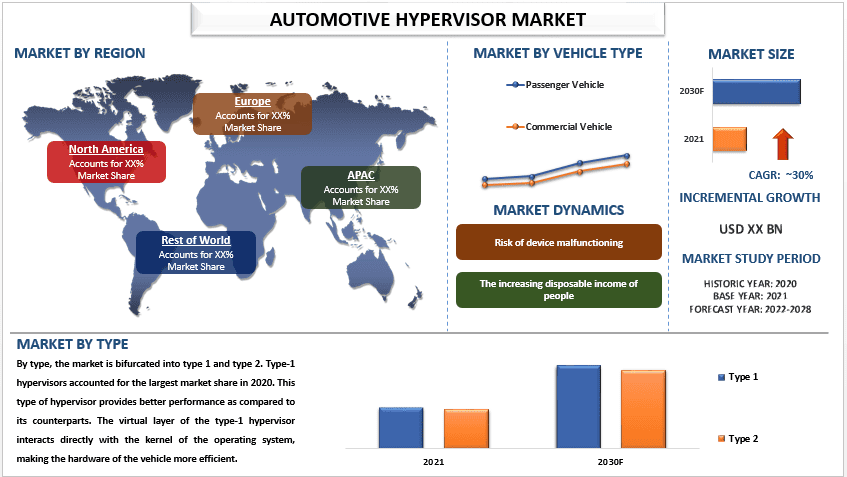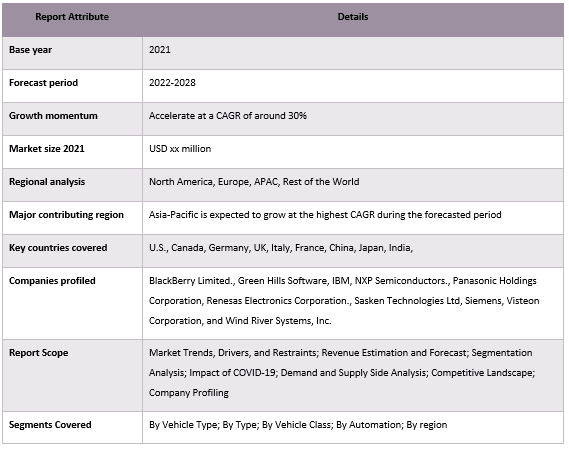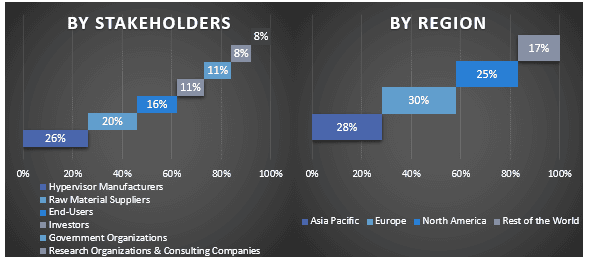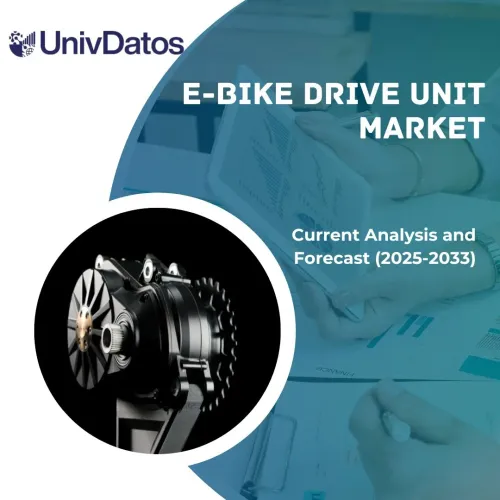
자동차 하이퍼바이저 시장은 고객의 인식이 높아지고, 신흥 경제국의 IoT 확산, 가처분 소득 및 도시화 급증으로 인해 예측 기간 동안 약 30%의 강력한 연평균 성장률(CAGR)로 성장할 것으로 예상됩니다. 더욱이 자동차 하이퍼바이저 기술의 필요성과 이점에 대한 인식이 높아짐에 따라 제품 개발 및 R&D 활동에 대한 투자가 전 세계적으로 증가했습니다. 새로운 플레이어들이 자동차 하이퍼바이저 환경에 진출하면서 경쟁이 치열해지고, 정부의 에너지 및 배출 정책이 진화하고, 자동차 하이퍼바이저 에너지 관리 시스템에 대한 수요가 증가하고, 스마트 가스 계량 서비스 개발이 이루어짐에 따라 특히 선진국 및 개발도상국에서 소비자들 사이에서 자동차 하이퍼바이저 장치의 보급이 증가하고 있습니다. 또한 자동차 하이퍼바이저 시장에 대한 투자 증가와 제품 출시가 시장 성장에 더욱 기여하고 있습니다.
시장에서 활동하는 주요 업체로는 BlackBerry Limited., Green Hills Software, IBM, NXP Semiconductors, Panasonic Holdings Corporation, Renesas Electronics Corporation, Sasken Technologies Ltd, Siemens, Visteon Corporation, Wind River Systems, Inc. 등이 있습니다. 이러한 업체들은 하이테크 혁신적인 제품/기술로 고객을 지원하기 위해 여러 건의 M&A와 파트너십을 체결했습니다.
보고서에 제시된 인사이트
"자동화 부문에서 반자율이 2021년에 시장의 상당 부분을 차지했습니다."
자동화에 따라 시장은 반자율과 완전 자율로 분류됩니다. 이 중에서 반자율 자동화는 완전 자율 자동화에 비해 완전 자율 주행으로 가는 보다 점진적인 단계이기 때문에 2021년에 자동차 하이퍼바이저 시장의 상당 부분을 차지했습니다. 반자율 시스템은 차선 이탈 경고, 어댑티브 크루즈 컨트롤, 자동 비상 제동과 같은 어느 정도의 자동화를 허용하지만, 필요한 경우 차량을 제어할 준비가 된 인간 운전자가 여전히 있어야 합니다.
"차량 유형 중 상용차가 예측 기간 동안 상당한 성장을 보일 것입니다."
기술별로 시장은 승용차와 상용차로 양분됩니다. 이 중에서 상용차는 예측 기간 동안 자동차 하이퍼바이저 시장에서 상당한 성장을 보일 것입니다. 이는 상용차가 승용차에 비해 더 발전되고 복잡한 시스템을 갖추고 있는 경우가 많으므로 이러한 시스템을 관리하기 위해 더 발전된 하이퍼바이저가 필요하기 때문입니다. 또한 상용차에는 첨단 운전자 보조 시스템(ADAS) 및 기타 안전 기능이 점점 더 많이 장착되고 있으며, 이러한 기능을 관리하려면 고급 컴퓨팅 성능과 하이퍼바이저가 필요합니다. 이러한 추세는 앞으로도 계속될 것으로 예상되며 상용차용 자동차 하이퍼바이저 시장의 성장을 견인할 것입니다.
자동차 하이퍼바이저 시장 보고서 범위

"북미가 2021년에 자동차 하이퍼바이저 시장을 지배했습니다."
북미는 여러 요인으로 인해 2021년에 자동차 하이퍼바이저 시장을 지배했습니다. 첫째, 북미는 Ford, General Motors, Chrysler와 같은 주요 업체가 있는 대규모 자동차 산업을 보유하고 있습니다. 이들 회사는 하이퍼바이저 기술을 조기에 채택하여 차량의 안전과 보안을 개선하는 데 사용해 왔습니다. 둘째, 이 지역은 하이퍼바이저에 필요한 하드웨어 및 소프트웨어를 제공하는 강력한 기술 회사 생태계를 보유하고 있습니다. 마지막으로, 이 지역의 규제 환경은 하이퍼바이저가 차량의 안전을 개선하는 방법으로 간주되므로 하이퍼바이저 채택을 장려합니다. 북미의 주요 시장 참여자들의 최근 개발은 자동차 하이퍼바이저 시장에서 이 지역의 지배력을 더욱 강화했습니다. 2021년 2월, 캐나다 소프트웨어 회사인 BlackBerry Limited는 하이퍼바이저 기술을 사용하여 안전하고 확장 가능한 지능형 차량 데이터 플랫폼을 개발 및 판매하기 위해 Amazon Web Services와 파트너십을 발표했습니다. 이 플랫폼을 통해 자동차 제조업체는 차량의 센서 및 기타 소스에서 데이터를 안전하게 액세스하여 차량 성능 및 고객 행동에 대한 통찰력을 얻을 수 있습니다. 결론적으로 자동차 하이퍼바이저 시장에서 북미의 지배력은 강력한 자동차 산업, 기술 생태계 및 규제 환경에 의해 주도됩니다.
이 보고서를 구매해야 하는 이유:
- 이 연구에는 인증된 주요 산업 전문가에 의해 검증된 시장 규모 및 예측 분석이 포함되어 있습니다.
- 이 보고서는 전체 산업 성과에 대한 빠른 검토를 한눈에 제공합니다.
- 이 보고서는 주요 비즈니스 재무, 제품 포트폴리오, 확장 전략 및 최근 개발에 대한 주요 초점을 맞춘 주요 산업 동료에 대한 심층 분석을 다룹니다.
- 산업에서 만연한 동인, 제약, 주요 추세 및 기회에 대한 자세한 조사.
- 이 연구는 다양한 세그먼트에서 시장을 포괄적으로 다룹니다.
- 산업에 대한 심층적인 지역 수준 분석.
맞춤 설정 옵션:
글로벌 자동차 하이퍼바이저 시장은 요구 사항 또는 기타 시장 세그먼트에 따라 추가로 맞춤 설정할 수 있습니다. 이 외에도 UMI는 귀하가 고유한 비즈니스 요구 사항을 가지고 있을 수 있음을 이해하므로 귀하의 요구 사항에 완전히 맞는 보고서를 받으려면 언제든지 저희에게 연락하십시오.
목차
시장 분석을 위한 연구 방법론 (2022-2028)
글로벌 자동차 하이퍼바이저 시장의 과거 시장 분석, 현재 시장 추정, 미래 시장 예측은 주요 지역에서의 자동차 하이퍼바이저 도입을 분석하고 생성하기 위해 수행된 세 가지 주요 단계입니다. 과거 시장 수치를 수집하고 현재 시장 규모를 추정하기 위해 광범위한 2차 연구가 수행되었습니다. 둘째, 이러한 통찰력을 검증하기 위해 수많은 결과 및 가정이 고려되었습니다. 또한, 글로벌 자동차 하이퍼바이저 시장의 가치 사슬 전반에 걸쳐 업계 전문가들과 광범위한 1차 인터뷰도 진행되었습니다. 1차 인터뷰를 통해 시장 수치를 가정하고 검증한 후, 전체 시장 규모를 예측하기 위해 상향식/하향식 접근 방식을 사용했습니다. 이후 시장 세분화 및 데이터 삼각 측량 방법을 채택하여 산업 관련 세그먼트 및 하위 세그먼트의 시장 규모를 추정하고 분석했습니다. 자세한 방법론은 아래에 설명되어 있습니다.
과거 시장 규모 분석
1단계: 2차 자료 심층 연구:
연례 보고서 및 재무 제표, 실적 발표, 보도 자료 등과 같은 회사 내부 자료와 저널, 뉴스 및 기사, 정부 간행물, 경쟁사 간행물, 부문 보고서, 타사 데이터베이스 및 기타 신뢰할 수 있는 간행물을 포함한 외부 자료를 통해 자동차 하이퍼바이저 시장의 과거 시장 규모를 얻기 위해 자세한 2차 연구가 수행되었습니다.
2단계: 시장 세분화:
자동차 하이퍼바이저 시장의 과거 시장 규모를 확보한 후 주요 지역의 다양한 세그먼트 및 하위 세그먼트에 대한 과거 시장 통찰력과 점유율을 수집하기 위해 자세한 2차 분석을 수행했습니다. 주요 세그먼트는 차량 유형, 유형, 차량 등급 및 자동화로 보고서에 포함되어 있습니다. 또한 해당 지역의 테스트 모델의 전반적인 채택을 평가하기 위해 국가 수준 분석을 수행했습니다.
3단계: 요인 분석:
다양한 세그먼트 및 하위 세그먼트의 과거 시장 규모를 확보한 후 자동차 하이퍼바이저 시장의 현재 시장 규모를 추정하기 위해 자세한 요인 분석을 수행했습니다. 또한 자동차 하이퍼바이저 시장의 차량 유형, 유형, 차량 등급 및 자동화와 같은 종속 및 독립 변수를 사용하여 요인 분석을 수행했습니다. 전 세계 자동차 하이퍼바이저 시장 부문에서 주요 파트너십, 합병 및 인수, 사업 확장 및 제품 출시를 고려하여 수요 및 공급 측면 시나리오에 대한 철저한 분석이 수행되었습니다.
현재 시장 규모 추정 및 예측
현재 시장 규모 결정: 위의 3단계에서 얻은 실행 가능한 통찰력을 바탕으로 현재 시장 규모, 글로벌 시장의 주요 업체 및 세그먼트의 시장 점유율에 도달했습니다. 필요한 모든 백분율 점유율 분할 및 시장 세분화는 위에서 언급한 2차 접근 방식을 사용하여 결정되었으며 1차 인터뷰를 통해 검증되었습니다.
추정 및 예측: 시장 추정 및 예측을 위해 이해 관계자가 사용할 수 있는 동인 및 추세, 제약 및 기회를 포함한 다양한 요인에 가중치가 부여되었습니다. 이러한 요인을 분석한 후 관련 예측 기술, 즉 상향식/하향식 접근 방식을 적용하여 전 세계 주요 시장의 다양한 세그먼트 및 하위 세그먼트에 대한 2028년 시장 예측에 도달했습니다. 시장 규모를 추정하기 위해 채택된 연구 방법론은 다음을 포함합니다.
- 국내 주요 시장에서 수익(USD) 측면의 산업 시장 규모 및 자동차 하이퍼바이저 시장의 채택률
- 시장 세그먼트 및 하위 세그먼트의 모든 백분율 점유율, 분할 및 세분화
- 제공되는 제품 측면에서 글로벌 자동차 하이퍼바이저 시장의 주요 업체. 또한 빠르게 성장하는 시장에서 경쟁하기 위해 이러한 업체가 채택한 성장 전략
시장 규모 및 점유율 검증
1차 연구: 주요 지역에서 최고 경영진(CXO/VP, 영업 책임자, 마케팅 책임자, 운영 책임자, 지역 책임자, 국가 책임자 등)을 포함한 주요 오피니언 리더(KOL)와 심층 인터뷰를 진행했습니다. 그런 다음 1차 연구 결과를 요약하고 통계 분석을 수행하여 명시된 가설을 입증했습니다. 1차 연구의 입력은 2차 연구 결과와 통합되어 정보를 실행 가능한 통찰력으로 전환했습니다.
다양한 지역의 1차 참가자 분할

시장 엔지니어링
데이터 삼각 측량 기술은 전체 시장 추정을 완료하고 글로벌 자동차 하이퍼바이저 시장의 각 세그먼트 및 하위 세그먼트에 대한 정확한 통계 수치를 얻기 위해 사용되었습니다. 데이터는 글로벌 자동차 하이퍼바이저 시장에서 차량 유형, 유형, 차량 등급 및 자동화 분야의 다양한 매개변수와 추세를 연구한 후 여러 세그먼트 및 하위 세그먼트로 분할되었습니다.
글로벌 자동차 하이퍼바이저 시장 연구의 주요 목표
글로벌 자동차 하이퍼바이저 시장의 현재 및 미래 시장 동향이 연구에서 정확히 지적되었습니다. 투자자는 연구에서 수행된 질적 및 양적 분석에 대한 투자를 기반으로 재량권을 얻기 위한 전략적 통찰력을 얻을 수 있습니다. 현재 및 미래 시장 동향은 지역 수준에서 시장의 전반적인 매력도를 결정하여 산업 참가자가 최초 진입자 이점을 통해 이익을 얻기 위해 미개척 시장을 활용할 수 있는 플랫폼을 제공합니다. 연구의 다른 양적 목표는 다음과 같습니다.
- 가치(USD) 측면에서 자동차 하이퍼바이저 시장의 현재 및 예측 시장 규모를 분석합니다. 또한 다양한 세그먼트 및 하위 세그먼트의 현재 및 예측 시장 규모를 분석합니다.
- 연구의 세그먼트에는 차량 유형, 유형, 차량 등급 및 자동화 영역이 포함됩니다.
- 자동차 하이퍼바이저에 대한 규제 프레임워크 정의 및 분석
- 다양한 중개인의 존재와 관련된 가치 사슬을 분석하고 업계의 고객 및 경쟁사 행동을 분석합니다.
- 주요 지역에 대한 자동차 하이퍼바이저 시장의 현재 및 예측 시장 규모를 분석합니다.
- 보고서에서 연구된 지역의 주요 국가에는 아시아 태평양, 유럽, 북미 및 기타 지역이 포함됩니다.
- 자동차 하이퍼바이저 시장의 회사 프로필과 빠르게 성장하는 시장에서 지속하기 위해 시장 플레이어가 채택한 성장 전략.
- 산업에 대한 심층적인 지역 수준 분석
관련 보고서
이 상품을 구매한 고객님들도 함께 구매하신 상품










